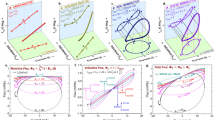Abstract
The memristor was introduced as a nonlinear circuit element in 1971, and systems showing memristor-like properties such as zero-crossing hysteresis loops were described in 1976. In 2008, a thin-film system that behaved like a memristor over some part of its operating region was discovered. Memristors and memristive systems have thus become a hot research area in recent years, making it important to discover and study such systems that show memristive behavior. Memristors and memristive systems exhibit three distinguishing characteristics that are known as their three fingerprints. Discharge lamps were also shown to exhibit memristive behavior recently. The diac, an electronics component commonly used in alternating-current (AC) applications, exhibits a breakdown mechanism similar to that observed in discharge lamps. According to textbooks, a diac should also obey the characteristics of a memristive system. In this work, a phenomenological model for a diac is first presented, and it is shown that this model satisfies the description of a memristive system; circuit simulations are also used to verify the memristive system behavior of a diac. However, experiments performed on a DB32 diac reveal that it only behaves like a memristive system in a narrow frequency range around 1 kHz. The effect of the junction capacitances of the diac are found to be important in this regard, resulting in the deviation of the diac from the expected memristive system behavior, as supported by the model and circuit simulations. We also believe that the reverse recovery current at frequencies above 1 kHz inhibits the zero-crossing behavior of the diac, even though its hysteresis curve is very similar to that of a memristive system.





















Similar content being viewed by others
References
Chua, L.O.: Memristor—the missing circuit element. IEEE Trans. Circuit Theory 18, 507–519 (1971)
Chua, L.O., Sung Mo, K.: Memristive devices and systems. Proc. IEEE 64, 209–223 (1976)
Di Ventra, M., Pershin, Y.V., Chua, L.O.: Circuit elements with memory: memristors, memcapacitors and meminductors. Proc. IEEE 97, 1717–1724 (2009)
Strukov, D.B., Snider, G.S., Stewart, D.R., Williams, R.S.: The missing memristor found. Nature (London) 453, 80–83 (2008)
Pershin, Y.V., Martinez-Rincon, J., Di Ventra, M.: Memory circuit elements: from systems to applications. J. Comput. Theor. Nanosci. 8(3), 441–448 (2011)
Prodromakis, T., Toumazou, C.: A review on memristive devices and applications. In: 2010 17th IEEE international conference on electronics, circuits and systems
Pershin, Y.V., Di Ventra, M.: Memory effects in complex materials and nanoscale systems. Adv. Phys. 60, 145–227 (2011)
Kavehei, O., et al.: The fourth element: characteristics, modelling and electromagnetic theory of the memristor. Proc. R. Soc. A: Math. Phys. Eng. Sci. 466(2120), 2175–2202 (2010)
Chua, L.: Resistance switching memories are memristors. Appl. Phys. A 102, 765–783 (2011)
Chua, L.O.: The fourth element. Proc. IEEE 100, 1920–1927 (2012)
Prodromakis, T., Toumazou, C., Chua, L.: Two centuries of memristors. Nat. Mater. 11, 478–481 (2012)
Marani, R., Gelao, G., Perri, A.G.: A review on memristor applications. Int. J. Adv. Eng. Technol. 8(3), 294 (2015)
Johnsen, G.K., et al.: Memristive model of electro-osmosis in skin. Phys. Rev. E 83(3), 031916 (2011)
Pershin, Y.V., Di Ventra, M.: Experimental demonstration of associative memory with memristive neural networks. Neural Netw. 23(7), 881–886 (2010)
Zhang, Y., et al.: Memristive model for synaptic circuits. IEEE Trans. Circuits Syst. II: Express Br. 64(7), 767–771 (2017)
Chua, L.O., Tseng, C.-W.: A memristive circuit model for p-n junction diodes. Int. J. Circuit Theory Appl. 2(4), 367–389 (1974)
Pershin, Y.V., Di Ventra, M.: Spin memristive systems: spin memory effects in semiconductor spintronics. Phys. Rev. B 78(11), 113309 (2008)
Chua, L., Sbitnev, V., Kim, H.: Hodgkin–Huxley axon is made of memristors. Int. J. Bifurc. Chaos 22, 1230011 (2012)
Krzysteczko, P., Reiss, G., Thomas, A.: Memristive switching of MgO based magnetic tunnel junctions. Appl. Phys. Lett. 95(11), 112508 (2009)
Barnes, B.K., Das, K.S.: Resistance switching and memristive hysteresis in visible-light-activated adsorbed ZnO thin films. Sci. Rep. 8(1), 2184 (2018)
Lin, D., RonHui, S.Y., Chua, L.O.: Gas discharge lamps are volatile memristors. IEEE Trans. Circuits Syst. I: Regul. Pap. 61(7), 2066–2073 (2014)
Kassakian, J.G., Schlecht, M.F., Verghese, G.C.: Principles of Power Electronics. Graphis, New York (2000)
Rashid, M.H. (ed.): Power Electronics Handbook. Butterworth-Heinemann, London (2017)
Boylestad, R.L.: Electronic Devices and Circuit Theory. Pearson Education India, Bangalore (2009)
Mohan, N.: Power Electronics: A First Course. Wiley, New York (2011)
Uzunoğlu, C. P., Babacan, Y., Cekli, S., Kaçar, F., Ugur, M.: Modelling of compact fluorescent lamp characteristics using memristor emulator circuit. In: International Conference on Memristive Materials, Devices & Systems (MEMRISYS 2017) (2017)
Linn, E., et al.: Complementary resistive switches for passive nanocrossbar memories. Nat. Mater. 9(5), 403 (2010)
Karakulak, E., Mutlu, R., Ucar, E.: Reconstructive sensing circuit for complementary resistive switches-based crossbar memories. Turk. J. Electr. Eng. Comput. Sci. 24(3), 1371–1383 (2016)
Adhikari, S.P., et al.: Three fingerprints of memristor. IEEE Trans. Circuits Syst. I: Regul. Pap. 60(11), 3008–3021 (2013)
LTSpice | Design Center | Analog Devices. Retrieved April 10, 2020, from https://www.analog.com/en/design-center/design-tools-and-calculators/ltspice-simulator.html
Diotech Semiconductor DB32 Datasheet. Retrieved April 10, 2020, from https://www.tme.eu/Document/2ba296385e9d036c34c3dddbd0f8d2e8/db3.pdf
Author information
Authors and Affiliations
Corresponding author
Additional information
Publisher’s Note
Springer Nature remains neutral with regard to jurisdictional claims in published maps and institutional affiliations.
Rights and permissions
About this article
Cite this article
Karakulak, E., Mutlu, R. The memristive system behavior of a diac. J Comput Electron 19, 1344–1355 (2020). https://doi.org/10.1007/s10825-020-01495-5
Published:
Issue Date:
DOI: https://doi.org/10.1007/s10825-020-01495-5




